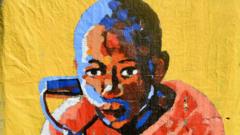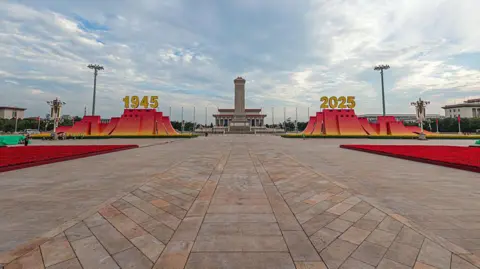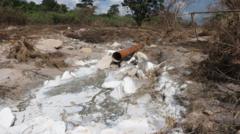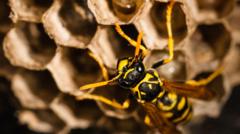Stary Mwaba stands as a significant voice in Zambian art, utilizing his work to shine a light on the dangerous realities faced by miners in the Copperbelt region. Known for the vast heaps of mining waste dubbed the "black mountains," Mwaba's latest exhibition at the Lusaka National Museum articulates the tales of young individuals risking their lives amidst toxic waste in search of copper ore. These mountains, a byproduct of a century-long mining history, are a symbol of both economic opportunity and environmental devastation.
"Growing up, we called these mountains 'mu danger'"—a phrase which means 'in danger'—recalled Mwaba, whose childhood memories of playing near these hazardous sites profoundly inform his art. Today, young men sift through the stone and slag, driven by desperation in a region with youth unemployment rates reaching 45%. They navigate treacherous tunnels, often at the mercy of gang masters known as "jerabos," to find precious copper ore—even though their work is typically illegal and fraught with peril.
Mwaba's latest series includes large portraits crafted from old newspaper collages, symbolizing how individual narratives become intertwined within broader societal issues. Through a process where he burns away portions of newspaper articles, Mwaba allows for a rehabilitation of these "grand narratives," inserting the personal stories of the miners he knows. This artistic methodology addresses both the fragility of life's stories and the strength of community bonds, where art and life interweave.
One notable piece, titled "Jerabo," captures the essence of a miner preparing to descend into a precarious tunnel, while "Shofolo" celebrates the significance of a shovel in the lives of young miners, whom Mwaba describes as "life lines." Additionally, his representations portray the communal joys found despite hardship, as captured in "Ipenga," highlighting the vibrant local culture surrounding church and social gatherings.
Mwaba’s artistic journey stemmed from a scientific inquiry sparked by his daughter’s school project, leading him to delve deeper into the effects of foreign influences on Zambian mining. Since his return from an art residency abroad, he has sought not only to document the overlooked struggles of these miners but to facilitate conversations around their experiences and aspirations.
As Zambia continues to grapple with issues surrounding mining practices and environmental safety, Mwaba’s art serves as a powerful reminder of the individuals behind the industry—their stories echoing in the shadow of the black mountains where hope, survival, and community resilience persist amid great adversity. With communities heavily reliant on mining, the legacy of these sites extends beyond mere economy; it shapes lives and art, all intertwined in a narrative that demands to be heard.




















